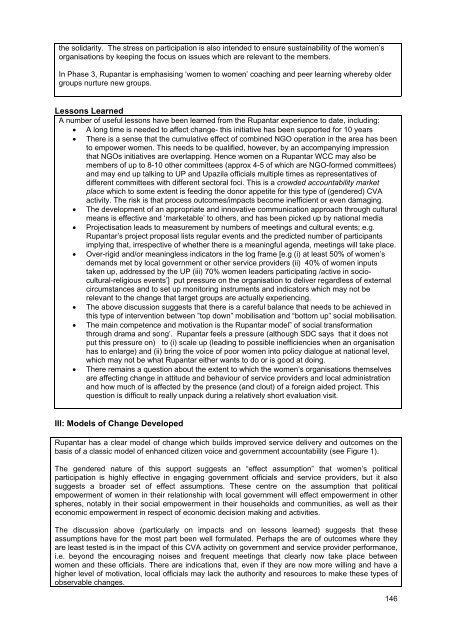Bangladesh - Belgium
Bangladesh - Belgium
Bangladesh - Belgium
Create successful ePaper yourself
Turn your PDF publications into a flip-book with our unique Google optimized e-Paper software.
the solidarity. The stress on participation is also intended to ensure sustainability of the women’s<br />
organisations by keeping the focus on issues which are relevant to the members.<br />
In Phase 3, Rupantar is emphasising ‘women to women’ coaching and peer learning whereby older<br />
groups nurture new groups.<br />
Lessons Learned<br />
A number of useful lessons have been learned from the Rupantar experience to date, including:<br />
• A long time is needed to affect change- this initiative has been supported for 10 years<br />
• There is a sense that the cumulative effect of combined NGO operation in the area has been<br />
to empower women. This needs to be qualified, however, by an accompanying impression<br />
that NGOs initiatives are overlapping. Hence women on a Rupantar WCC may also be<br />
members of up to 8-10 other committees (approx 4-5 of which are NGO-formed committees)<br />
and may end up talking to UP and Upazila officials multiple times as representatives of<br />
different committees with different sectoral foci. This is a crowded accountability market<br />
place which to some extent is feeding the donor appetite for this type of (gendered) CVA<br />
activity. The risk is that process outcomes/impacts become inefficient or even damaging.<br />
• The development of an appropriate and innovative communication approach through cultural<br />
means is effective and ‘marketable’ to others, and has been picked up by national media<br />
• Projectisation leads to measurement by numbers of meetings and cultural events; e.g.<br />
Rupantar’s project proposal lists regular events and the predicted number of participants<br />
implying that, irrespective of whether there is a meaningful agenda, meetings will take place.<br />
• Over-rigid and/or meaningless indicators in the log frame [e.g (i) at least 50% of women’s<br />
demands met by local government or other service providers (ii) 40% of women inputs<br />
taken up, addressed by the UP (iii) 70% women leaders participating /active in sociocultural-religious<br />
events’] put pressure on the organisation to deliver regardless of external<br />
circumstances and to set up monitoring instruments and indicators which may not be<br />
relevant to the change that target groups are actually experiencing.<br />
• The above discussion suggests that there is a careful balance that needs to be achieved in<br />
this type of intervention between ”top down” mobilisation and “bottom up” social mobilisation.<br />
• The main competence and motivation is the Rupantar model” of social transformation<br />
through drama and song’. Rupantar feels a pressure (although SDC says that it does not<br />
put this pressure on) to (i) scale up (leading to possible inefficiencies when an organisation<br />
has to enlarge) and (ii) bring the voice of poor women into policy dialogue at national level,<br />
which may not be what Rupantar either wants to do or is good at doing.<br />
• There remains a question about the extent to which the women’s organisations themselves<br />
are affecting change in attitude and behaviour of service providers and local administration<br />
and how much of is affected by the presence (and clout) of a foreign aided project. This<br />
question is difficult to really unpack during a relatively short evaluation visit.<br />
III: Models of Change Developed<br />
Rupantar has a clear model of change which builds improved service delivery and outcomes on the<br />
basis of a classic model of enhanced citizen voice and government accountability (see Figure 1).<br />
The gendered nature of this support suggests an “effect assumption” that women’s political<br />
participation is highly effective in engaging government officials and service providers, but it also<br />
suggests a broader set of effect assumptions. These centre on the assumption that political<br />
empowerment of women in their relationship with local government will effect empowerment in other<br />
spheres, notably in their social empowerment in their households and communities, as well as their<br />
economic empowerment in respect of economic decision making and activities.<br />
The discussion above (particularly on impacts and on lessons learned) suggests that these<br />
assumptions have for the most part been well formulated. Perhaps the are of outcomes where they<br />
are least tested is in the impact of this CVA activity on government and service provider performance,<br />
i.e. beyond the encouraging noises and frequent meetings that clearly now take place between<br />
women and these officials. There are indications that, even if they are now more willing and have a<br />
higher level of motivation, local officials may lack the authority and resources to make these types of<br />
observable changes.<br />
146

















